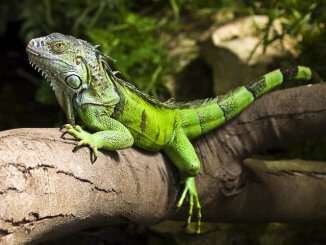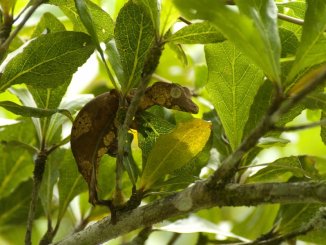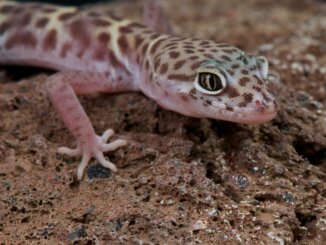
The blue tailed skink is the name for several similar, short-limbed lizard species. Two of the most common blue tailed skink species are the American blue tailed skink, hailing from forests and urban areas in Eastern United States, and the Pacific blue tailed skink, from Indonesia and Australia’s Christmas Island.
Blue tailed skinks are easy to care for and eat foods that are commonly available, so they’re a good choice for beginners with little-to-no lizard-keeping experience.
Blue Tailed Skink Overview
| Common name | Blue tailed skink, blue tail skink, five-lined skink |
| Scientific name | Emoia caeruleocauda (Pacific blue tailed skink), Plestiodon fasciatus (American blue tailed skink) |
| Natural habitat | Woodland and urban areas in Eastern United States, Australia, New Guinea, Malaysia, the Philippines, the Pacific Islands, and Indonesia |
| Adult size | 6–8.5 inches |
| Average lifespan | 6–10 years |
| Diet | Omnivore |
| Housing | Minimum 20 gallons per skink, 72–82°F air temperature, 60%–80% humidity |
| Experience | Beginner–intermediate |
Origin
The American blue tailed skink is found across the Eastern United States, from Missouri to Florida, and parts of South-Eastern Canada. The Pacific blue tailed skink is endemic to Australia’s Christmas Island and is now found in areas across Indonesia, New Guinea, Malaysia, the Philippines, and the Pacific Islands.
Both skink species live in areas of thick forest and rocky terrain. The lizards are found in trees, on logs, under leaves, on the ground, and in brush piles. Blue tailed skinks are semi-arboreal and climb trees to hide from predators. The lizards enjoy basking on logs and piles of brush.
Appearance and Behavior
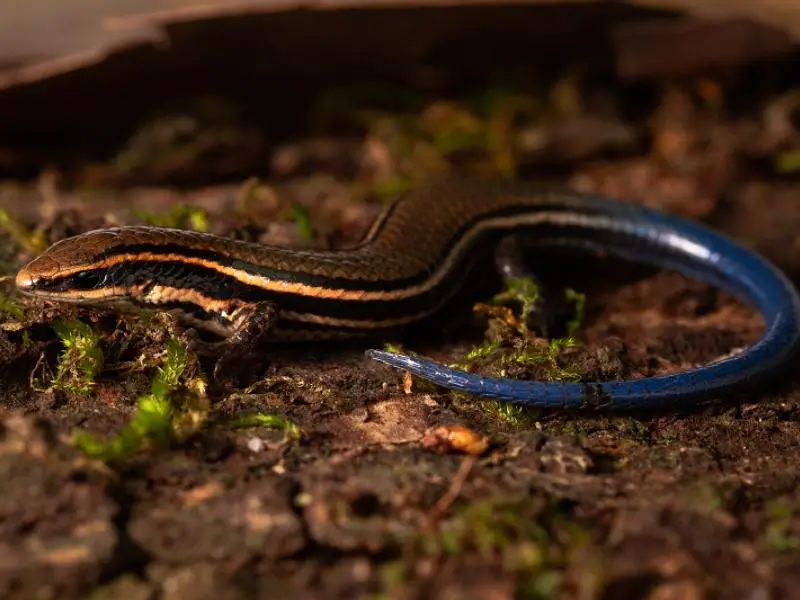
The American blue tailed skink and the Pacific blue tailed skink have similar appearances and are both named for their bright blue tails. The brightly colored tail is designed to attract a predator’s attention. Skinks can intentionally lose and regrow their tails, so if a predator catches them by the tail, they can escape and survive.
The lizards both have dark gray to brown or black bodies with light-colored stripes that run from snout to tail. As the lizards age, their stripes fade.
Pacific blue tailed skinks have separate horizontal stripes across the entire length of their bodies, while American blue tailed skinks have horizontal stripes that merge together at the back of their heads.
The American blue tailed skink’s bright blue tail changes color to grayish brown when the lizard becomes sexually mature.
There are several color morphs of blue tailed skinks, including a variation with a bright green tail, and a dark-colored variation.
Size and Lifespan
The Pacific blue tailed skink is the smaller blue tailed skink species, growing as long as 6 inches. American blue tailed skinks are slightly bigger, reaching 8.5 inches long in the wild. Female skinks are about half an inch smaller than males.
In captivity, both skink species live up to 10 years. In the wild, American blue tailed skinks live up to 6 years, while Pacific blue tailed skinks live for about 7 years.
Temperament
The blue tailed skink is an active lizard that enjoys climbing and basking in its habitat. Captive-bred blue tailed skinks are docile and calm, while wild-caught skinks are more likely to be skittish and aggressive. The lizards prefer not to be handled, so they’re best as a display-only species.
As a diurnal species, the blue tailed skink is most active during the day, and sleeps during the night. In the wild, the skink spends most of its time hunting for food and hiding from predators.
Blue tailed skinks are a sociable species, so you can house several skinks in the same enclosure. Male blue tailed skinks are known for displaying aggressive behavior toward one another. Prevent fighting and biting by housing one male with three or four females, rather than multiple males.
Housing Blue Tailed Skinks
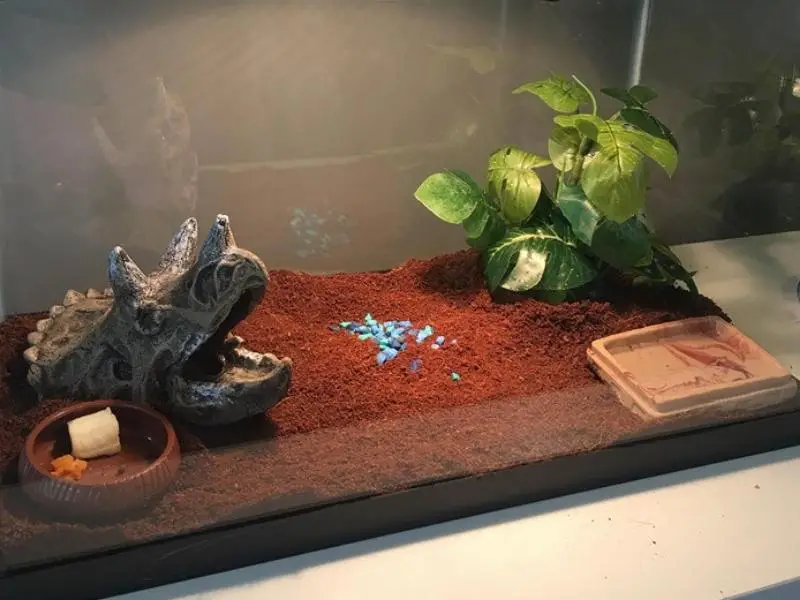
Although the American blue tailed skink and the Pacific blue tailed skink live in different parts of the world, the lizards’ climates and living conditions are similar. Mimic the blue tailed skink’s natural habitat in captivity to ensure the lizard is comfortable in its new environment.
Keep blue tailed skinks in a glass terrarium.
Enclosure size
An enclosure for a single blue tailed skink should be at least 20 gallons. For every additional skink, provide an extra 10 to 20 gallons of space.
Blue tailed skinks enjoy climbing, so the enclosure should be at least 18 inches tall to accommodate logs and tree branches. The length and width of the enclosure should be about 48 by 24 inches.
Lighting
Blue tailed skinks need between 10 and 12 hours of lighting per day so that they can tell the difference between day and night.
Install a UVB light above the roof of the enclosure to provide light throughout the entire space. UVB is essential for providing the vitamin D needed for the lizards to metabolize calcium.
If your enclosure contains live plants, consider installing a regular LED light to support plant growth. Otherwise, natural daylight from a nearby window should provide enough light to keep the lizard happy.
Temperature and Humidity
Your blue tailed skink’s enclosure should have a temperature gradient (a warm section and a cooler section) to allow the lizard to regulate its body temperature by moving between sections of the tank. Place a heat pad or a heat lamp in the basking area to make it warmer than the rest of the enclosure.
The ideal temperature range for an American blue tailed skink enclosure is 72–82°F. The basking spot should be 90–95°F.
Pacific blue tailed skinks need a temperature range of 77–82°F. The basking spot should be 110°F.
Use a thermometer to monitor temperatures in the enclosure.
Both blue tailed skink species require a humidity of 60%–80%. Maintain consistent humidity levels by placing a water bowl in the enclosure and keeping the space properly ventilated. A reptile fogger can also be used if necessary.
Substrate and Decoration
The ideal substrate for a blue tailed skink enclosure is a mold-resistant, humidity-holding substrate, like humus, orchid bark, or coconut fiber. Provide at least 4 inches of substrate to allow the lizard to burrow.
Replicate the skink’s woodland habitat with plants (live or artificial, depending on your maintenance preferences), rocks, logs, horizontal and vertical branches, and bark.
Make sure your skink has plenty of opportunities for hiding, exploring, and safely climbing in the enclosure. Dense foliage and branches will make your skink feel safe.
Cleaning
To prevent a dirty tank from making your lizard sick, spot-clean the enclosure once a day and perform a full deep clean at least once a month.
During your daily spot-clean, remove leftover food and waste from the enclosure and replenish soiled substrate. Wash out the water bowl and add a fresh batch of clean water.
To deep clean the enclosure, remove the lizard and place it in a temporary enclosure, then empty out all the decorations and discard the substrate. Soak the decorations in warm water and wipe down plants and rocks with a damp sponge.
Use a reptile disinfectant or warm water mixed with white vinegar to clean the walls and floor of the enclosure. Wipe the enclosure dry, then add a fresh layer of substrate, return the decorations, and move the skink back into its home.
Blue Tailed Skink Care

Blue tailed skinks are easy to care for and suitable for beginner reptile keepers. The blue tailed skink diet is easy to replicate in captivity, and the lizard is fairly hardy and tolerant of different temperatures in the enclosure.
Food and Water
In the wild, blue tailed skinks eat a mostly carnivorous diet of live insects, such as spiders and flies. The lizards also eat snails, earthworms, and occasionally fruit.
Provide a similarly protein-rich diet in captivity by feeding your skink crickets, earthworms, mealworms, dubia roaches, and fruit flies. Make sure the insects are gut-loaded (fed a diet packed with calcium and other nutrients) to provide extra nutritional value.
Hatchlings and young lizards should be fed baby crickets and fruit flies, which are the most nutritious of all protein sources. Dust the insects with calcium powder before feeding.
Feed the lizards enough food that they can eat in five minutes, then remove the leftovers from the tank to prevent a buildup of bacteria.
Handling
Blue tailed skinks prefer not to be handled, and may become stressed if they’re handled too frequently. Only handle your skink on necessary occasions, such as to transport the lizard to another tank or to perform a health check.
Neither blue tailed skink species is aggressive to humans, but American skinks may bite if they feel threatened and can’t easily escape. The bite isn’t venomous, so it isn’t dangerous to humans. Blue tailed skinks may lose their blue tail if they’re handled too roughly.
Common Health Issues
The blue tailed skink is a hardy lizard species, but there are several health issues to be aware of amongst skinks that are poorly looked after in captivity:
Metabolic Bone Disease
Lizards that don’t get enough calcium or vitamin D are susceptible to metabolic bone disease. Symptoms of this disease are an arched spine, bowed or swollen legs, and softening of the jaw. Treat the disease by immediately increasing the lizard’s calcium intake by dusting its food with calcium powder. Install a UVB light above the enclosure if you don’t already have one.
Parasites
Wild skinks may carry parasites, including ticks, which become a problem in the enclosure. American blue tailed skinks are known for carrying ticks that transmit Lyme disease, which is dangerous to humans. Avoid buying wild-caught skinks to eliminate the possibility of parasites entering your home.
Bite Injuries
If multiple male blue tail skinks are housed together, the skinks may fight and bite one another, causing open wounds. Treat bite injuries with a light layer of antibiotic ointment. Arrange an appointment with your local exotic veterinarian to treat serious injuries. Prevent bite injuries by housing one male with several females, and avoiding housing multiple males together.
Breeding
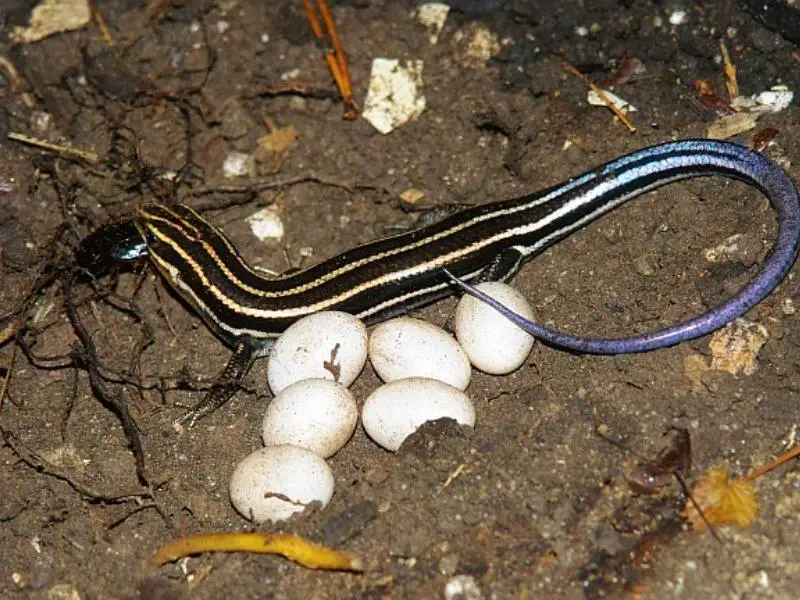
In the wild, male blue tail skinks use chemical cues to locate females, then court the females during breeding season. Males fight their rivals and breed with many females throughout their lifespan, increasing the chance of producing offspring.
The male blue tailed skink reaches sexual maturity at about 12 months old, while females become sexually mature at 24 months old.
Breeding blue tail skinks in captivity is possible. For the highest chance of breeding success, follow these steps:
- Place one male and three or four females in the same enclosure
- The male will court the females. If a female is interested, the pair will mate
- The female will make a nest, usually in tree stumps or under logs, and lay two eggs at a time (up to 13 eggs in total)
- Transfer the eggs into an incubator set to your tank’s ambient temperature to prevent the adults from damaging them
- Once the eggs have hatched, transfer the hatchlings to a separate enclosure from their parents to prevent the adults from eating the babies
- Feed the hatchlings fruit flies and small crickets until they’re big enough to be transferred into separate enclosures or sold (around one year old)
Choosing and Buying a Blue Tailed Skink
The average cost of a blue tailed skink is $15–$100. These skinks are quite rare in the reptile industry. Your best chance of finding a skink of this species is to look for breeders online.
Before spending your money, ask the breeder to see pictures and videos of the lizard to check its movements and eating habits are healthy. Ideally, see the skink in person before you buy it. Avoid skinks that look underweight, have open wounds or body swellings, are lame in one or several limbs, or have bubbles or discharge from the mouth or nose. Choose a healthy-looking lizard with bright, wide-open eyes, supple skin, and moist gums.

